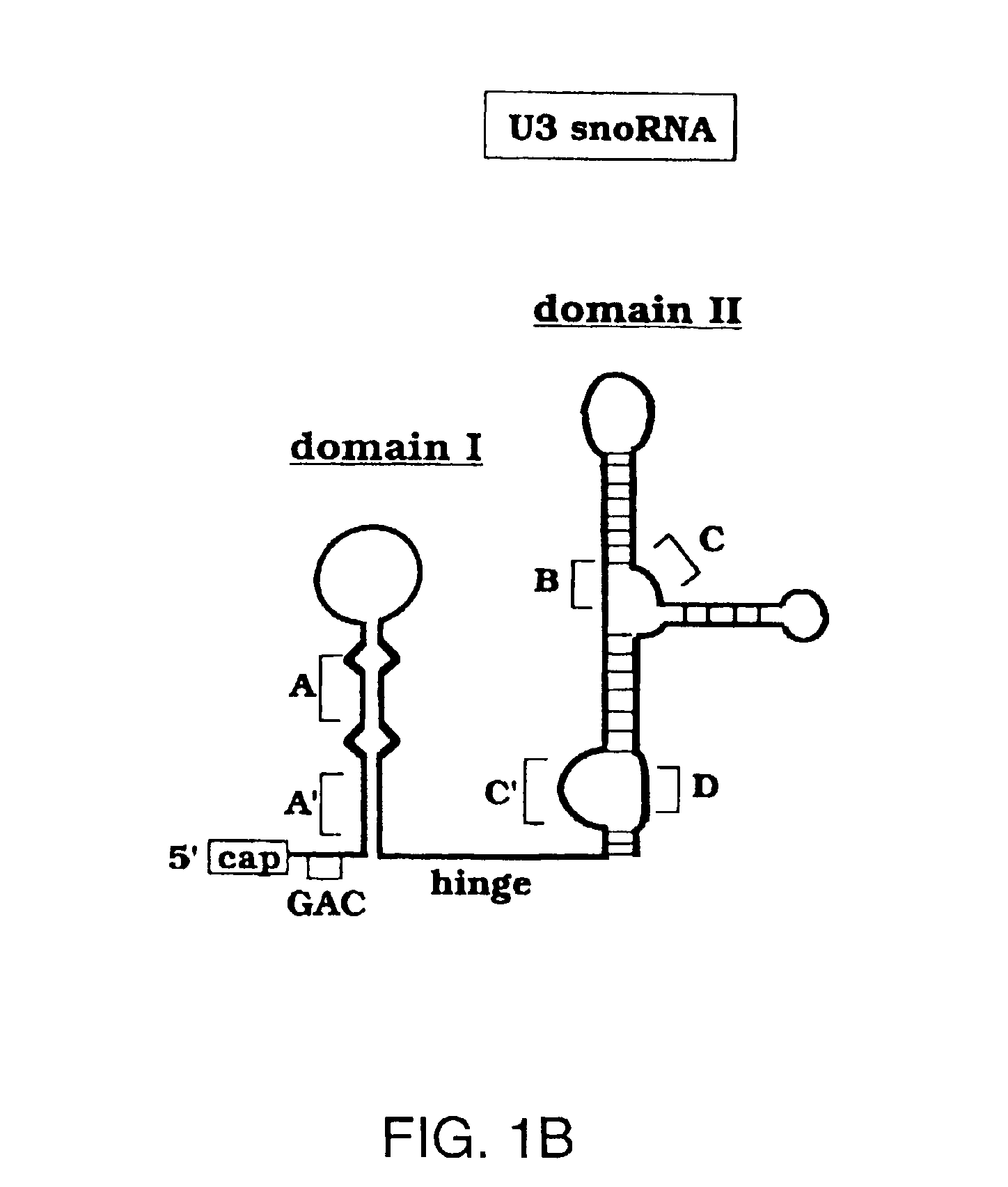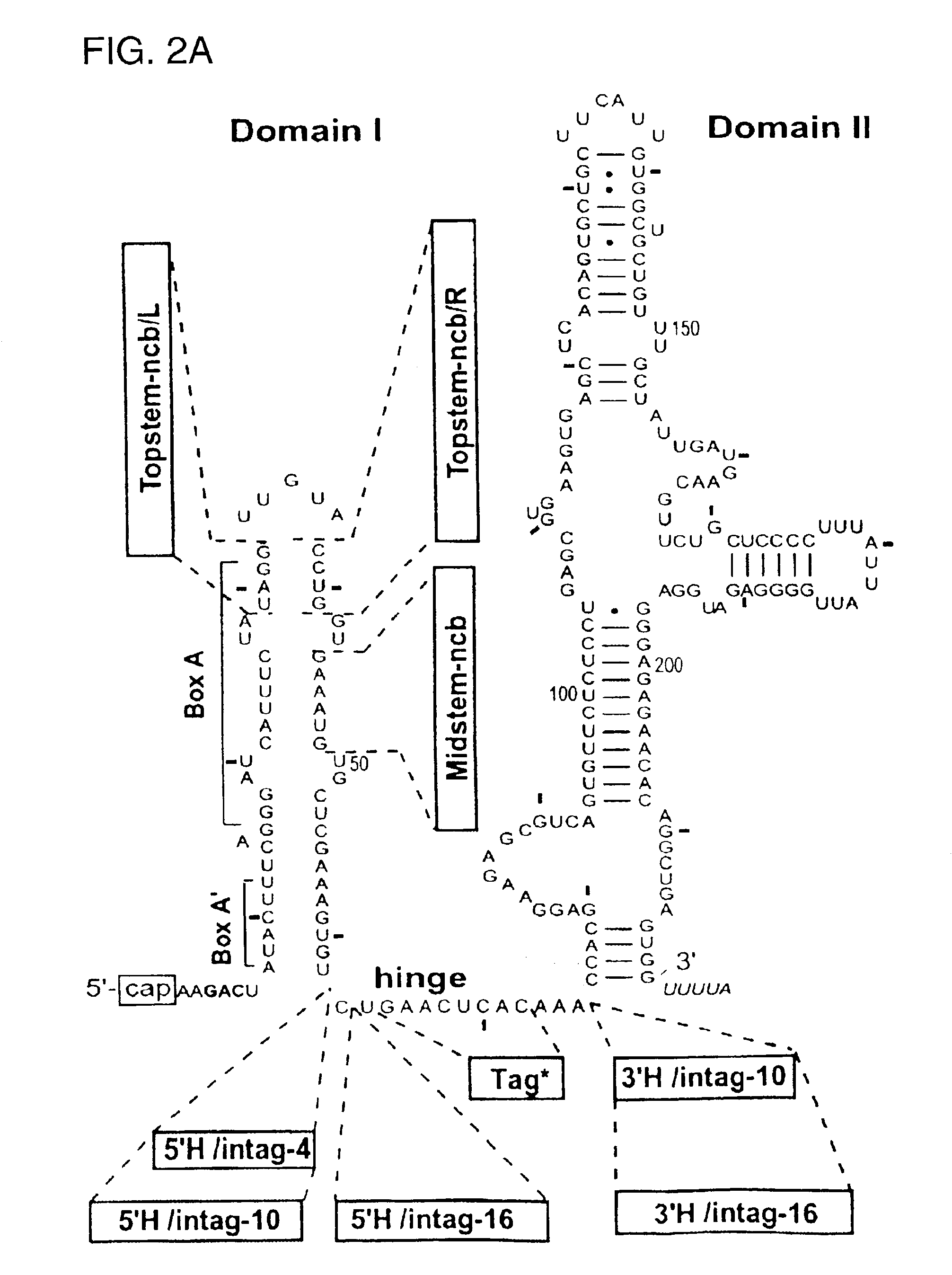Methods to screen for antibiotic agents and their use in treatment of opportunistic infections
a technology of ribonucleic acid and antibiotics, applied in the direction of antiparasite agents, biochemistry apparatus and processes, drug compositions, etc., can solve the problems of severe disability or even life-threatening of infectious diseases, extreme economic losses, and significant economic losses in animal husbandry, so as to prevent or disrupt cell viability, and prevent or disrupt cell division
- Summary
- Abstract
- Description
- Claims
- Application Information
AI Technical Summary
Benefits of technology
Problems solved by technology
Method used
Image
Examples
example 2
The 5′ Hinge Region of Domain I of U3 snoRNA Must Contain Box A′ and be Single-Stranded for U3 Function in 18S rRNA Production
[0157]We showed that the base of the putative stem of U3 domain I is required for the U3 snoRNA function in the Xenopus oocyte model system. Xenopus oocytes were isolated and treated as described previously (Borovjagin and Gerbi, 1999). Briefly, endogenous U3 snoRNA was depleted by two sequential injections spaced 4 hours apart of an antisense oligonucleotide complementary to U3 nt 39-54. Newly synthesized pre-rRNA was in vivo labeled by injection of 0.5 μCi-32P-UTP (4000 Ci / mmol; New England Nuclear, Boston, Mass.). Capped snoRNAs were transcribed in vitro by T7 RNA polymerase (Ambion Megashortscript kit, Austin, Tex.) and 9.2 nl of 0.5 ng / nl to 1.5 ng / nl was injected 4 hours after the last depletion of endogenous U3 to assay its ability to restore 18S rRNA processing. Total nuclear RNA was extracted from 5-10 oocytes by the Rapid Total RNA Isolation kit (5 ...
example 3
Base-pairing at the Top of the Putative Stem in Domain I of U3 snoRNA is Unnecessary for rRNA Processing
[0178]We also inquired whether base-pairing at the top of the putative stem of domain I of U3 snoRNA is needed for function in rRNA processing. When either side of the top of the putative stem was mutated to disrupt potential base-pairing (FIG. 2A: Topstem-ncb / L and Topstem-ncb / R), 18S rRNA was still produced (FIG. 5, lanes 3 and 5), although at slightly lower levels (75-80%) than with wild type U3 snoRNA. Thus, a base-paired structure at the top of the putative stem is not essential for U3 function in 18S rRNA processing, nor are the sequences on either side of the putative stem important. The compensatory mutation was created (Topstem-cb) which is a U3 double mutation containing Topstem-ncb / R and Topstem-ncb / L. In this double mutant, the wild type sequences of U3 snoRNA at the top of the putative stem are swapped and base-pairing is still possible. When the double mutant Topstem...
example 4
The 5′ Hinge Sequence in the Middle of the Putative Stem of Domain I of U3 snoRNA is Important for 18S rRNA Formation
[0179]Several lines of evidence indicate that a sequence in the middle (right side) of the putative stem of domain I is important for U3 function in rRNA processing. First, only inefficient rescue of 18S rRNA was seen with the U3 mutant subtag-16 (FIG. 4, lanes 3-4). Since the 10 nt at the 3′ end of this substitution were identical to those in subtag-10 that had no adverse effect (FIG. 4, lane 7), it seemed that mutation of the 6 nt at the 5′ end of subtag-16 was responsible for impairing U3 snoRNA function. These sequences invade the middle of the putative stem of domain I (FIG. 2C: subtag-16), and the results suggest their importance for U3 function. To investigate this region further, the U3 mutation Midstem-ncb was created in which the right side of the middle of the putative stem of domain I of U3 snoRNA was replaced by another sequence (FIG. 2A). As can be seen ...
PUM
| Property | Measurement | Unit |
|---|---|---|
| pH | aaaaa | aaaaa |
| concentration | aaaaa | aaaaa |
| pH | aaaaa | aaaaa |
Abstract
Description
Claims
Application Information
 Login to View More
Login to View More - R&D
- Intellectual Property
- Life Sciences
- Materials
- Tech Scout
- Unparalleled Data Quality
- Higher Quality Content
- 60% Fewer Hallucinations
Browse by: Latest US Patents, China's latest patents, Technical Efficacy Thesaurus, Application Domain, Technology Topic, Popular Technical Reports.
© 2025 PatSnap. All rights reserved.Legal|Privacy policy|Modern Slavery Act Transparency Statement|Sitemap|About US| Contact US: help@patsnap.com



